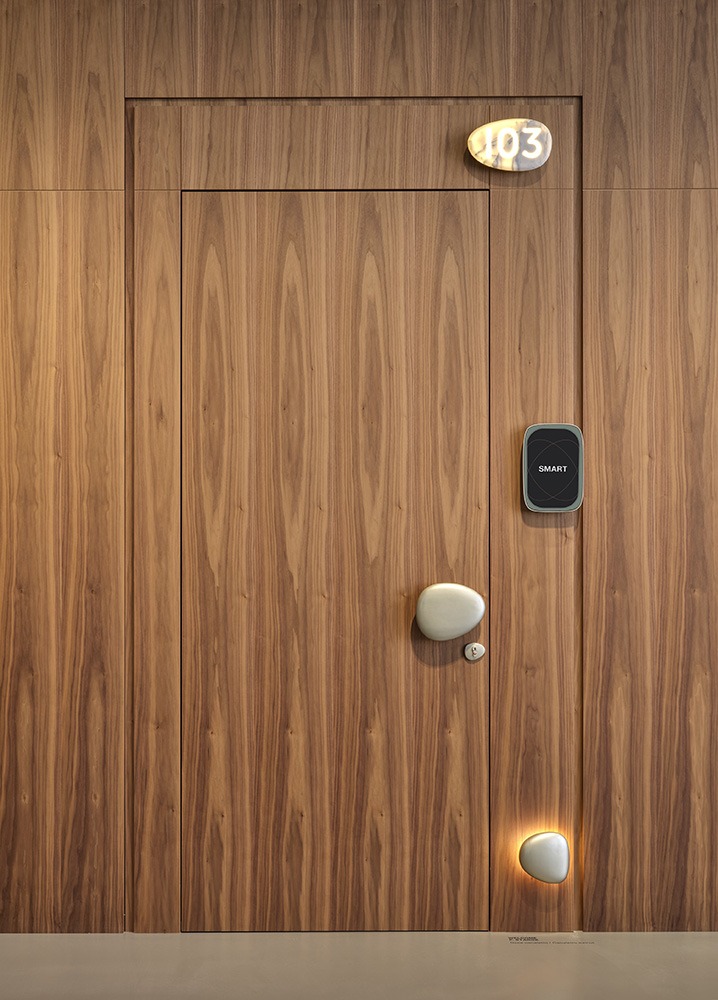If we look at the power that technology has wielded in changing objects and processes that have remained unchanged for decades, we can find few elements untouched by the hi-tech wave. One of these is the door (another is the window), not intended as a store window, or as a point of access to parks, attractions or children’s playgrounds, but as a gateway into the home. So even in hotel rooms, which are temporary but still homes, and which so far have been affected by change only because of smart locks that simplify and speed entry. With the insights of some of the wittiest designers of our time, even doors have gradually become the subject of investigation, with the aim of rethinking their functionality to adapt them to the sign of the times.
The intuition of Philippe Starck
At the Salone Internazionale del Mobile, staged last September in Milan, a model was previewed that embraces technology and breaks with the patterns of the past. It is called Welcome, a name that encompasses several meanings, the first of which is to underline the passage into a new world. Symbol of the collection of the same name (which also includes Shoin, sliding glass doors, and Altaj, a hinged door with a three-dimensional grid profile) launched by Lualdi, an Italian company specializing in interior doors and founded in 1859 as a craft carpenter’s workshop, now run by the fourth family generation, the door was designed by Philippe Strack and, thanks to its accentuated innovative scope, was one of the most popular novelties at the world’s most important trade fair for the home-furnishing sector.

“We have established a fruitful collaboration with Philippe Starck,” says Pierluigi Lualdi, head of the Contract area of the Italian brand. “We love his provocative pencil and attitude in creating objects with original shapes. He defines himself as an explorer of the future and in fact we have designed an object projected into the future, inventing a time in which the door no longer has only the function of a passage between one environment and another but can provide services and interact with people”. Conceived for the hotel industry, Welcome is based on the system of accessories, handle, step marker and number, to which a tablet is added, which comes to life on the door.
The door is a service tool
In this way, the door is transformed into a service tool, responsible for the recognition of faces, for heating the rooms, for sending messages, for welcoming and protection. Due to the need for hotels to rely on customizable products, all Welcome accessories are customizable, including the finishes that can be aluminum, wood or matte lacquer, so as to adapt shapes and styles to the aesthetics of each type of hotel, while offering customers the opportunity to take advantage of facial recognition to check-in and check-out, communicate remotely with hotel staff and control all automated services of the room, even remotely via mobile apps.

Famous for about 10 thousand patents and for having created objects that have become icons over time – such as the Juicy Salif juicer, the ‘spider squeezer’ designed in 1990 for the Italian company Alessi and now on display in the permanent collections of the MoMa in New York and the Centre Georges Pompidou in Paris, and such as the Louis Ghost chair of 2002 on which even Queen Elizabeth II was photographed – Starck’s aim with Welcome is to create an object that is solid and durable, but also updatable, so as to avoid the risk of a life cycle that is too short for the speed with which digital technology spreads and improves.
For the French designer, the device-door is a model that combines style and flexibility, since its precise identity is combined with a modular system, to be updated over time in a simple and convenient way (for example, with 3D printing). Just what is needed to ensure the interactive and connected door a longevity that can ensure at least 10 years of life with the hope of reaching 20-30 years, a necessary prerogative to allow the hotel industry to bet on a product without hesitation. Also because, with the absence of similar solutions, Welcome represents an avant-garde collection to renew environments and distinguish itself from competitors, in a sector where details and the ability to create innovative spaces are an effective ally to attract customers.

Going beyond the innovative potential of intuition, however, Welcome is for the Venice-based architect and designer only the first step in a long process of door transformation. “Doors of the future will become so smart that they will communicate with each other and organize themselves to manage activity in the home through artificial intelligence. In this way they are destined to become smarter than humans.”



